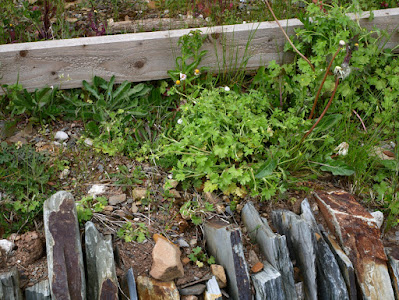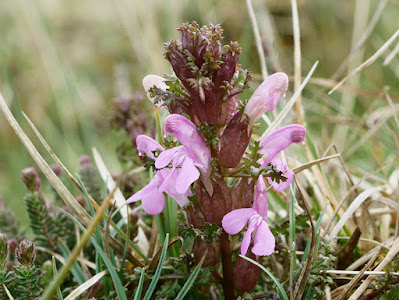I thought it would be a good idea to show readers what happens to our validated botanical records, so for each species, I have included a link to the BSBI 2020 Atlas webpage. Here it shows you the UK distribution, a species trend, whether it's doing well or not (most are not), photographs of most species and a summary for it. I hope you make use of it and who knows, become a botanical or biological recorder yourself?
I've seen thousands of Green-winged Orchids in Kent and Sussex previously, but I thought it would be nice to see the Cornish ones, so I headed off to The Lizard area where I knew some might be found. It didn't take too long to find them, but they only grew in short turf around rocky outcrops back from the sea and were few in number, compared to those pristine inland meadows of SE England with thousands of plants in them.
See https://plantatlas2020.org/atlas/2cd4p9h.6y71f0
They were pretty much all this colour and ranged from about 6 to 15cm tall, so they were quite dwarfed too. What was different about them was the flora they grew with, so there was a nice combination of Spring Squill growing amongst them, something you don't see further East.
Anacamptis morio
Not far away from them were acres of dry heath, typically with Heather with Cross-leaved Heath in Purple Moor Grass grassland. Intertwining amongst them were lots of Petty Whin, a small, weakly spiny shrub much like a miniature Gorse.
Genista anglica
Petty Whin has undergone a dramatic decline over the last century, you can read all about it here - https://plantatlas2020.org/atlas/2cd4p9h.8n8
Also on the dry heath, but usually by paths, were the rich blue flowers of Heath Milkwort.
Polygala serpyllifolia
It can tricky to tell Common Milkwort apart from this species, but to do so you have to look at the base of the stem. In Heath Milkwort, the leaves will be opposite (or if fallen off, leaf scars will be opposite), in Common Milkwort they are alternate all up the stem. Furthermore, it is rare for Common Milkwort to grow on acidic soils, so habitat often narrows your options down too.
See: https://plantatlas2020.org/atlas/2cd4p9h.fka
Dwarf roses were dotted amongst the heath too, these were Burnet Roses which have not only thorns but impressive rows of sharp bristles up the stem too. Later in the year, they will have black hips (seed pods) unlike the usual roses that have red ones.
See: https://plantatlas2020.org/atlas/2cd4p9h.5k8
Rosa spinosissima
Procumbent Pearlwort (below) is a common plant, both in the countryside, but also in towns in pavement cracks. It normally has four petals and mostly lacks any petals, but here I found a large plant with 4 and 5 petals on it, so I have included it to show the variation in this species.
See: https://plantatlas2020.org/atlas/2cd4p9h.m20
Sagina procumbens
I had never seen Eyelash Fungus before and from online photos, I had assumed they were about 2-3cm across. On the damper places on the heath, but especially on paths, I noticed orange/red tiny blobs on the ground and eventually bent down to look closer. Of course, it was this fungus. The first photo below was the biggest one which was about 1cm across, look at those lashes!
Scutellinia scutellata
One of the dominant plants here was the Black Bog-Rush, so called after its very dark coloured fruiting heads. It's a tussocky plant with stiff leaves that end abruptly in its seedhead as shown in the second photo below. It has a quite Westerly distribution and is often found on damp, acidic moors, bogs and heaths.
See: https://plantatlas2020.org/atlas/2cd4p9h.m3b
See: https://plantatlas2020.org/atlas/2cd4p9h.cpn
Trifolium occidentale
Whilst there I had to pay a visit to The Lizard village car park as it contains some unusual plants. In the car park can be found Greek Sea Spurrey, but I couldn't find any in flower. While looking for flowers, I came across Sand Spurrey which has a larger (though still tiny) flower and leaf like bracts below the flower (Greek has shortened bracts).It is also far less glandular hairy than Greek Sea Spurrey.
See: https://plantatlas2020.org/atlas/2cd4p9h.cm5
Spergularia rubra
The car park is also well known for having a population of Red Shepherd's Purse. Unlike the usual form, the whole plant is red, stems, branches and pods.
See: https://plantatlas2020.org/atlas/2cd4p9h.b5e
Capsella rubella
My final plant species is the lovely Cornish or Western Ramping Fumitory, endemic to Cornwall.
See: https://plantatlas2020.org/atlas/2cd4p9h.558
It has the largest flower of the Fumitories in the UK upto 14-15mm and a white rim to the spanner head shaped top petal. This tells it apart from all the other species. This plant was at least three feet wide and scrambling up other plants to about 5 feet tall.
Fumaria occidentalis
So ended a nice day out to The Lizard area. I didn't go and visit the rarest clovers site as it was in the opposite direction to where I wanted to go. I also looked for Pygmy Rush but was a few weeks early, but I am sure I will find it later in the month when I return.
Take Care
Dave






















































